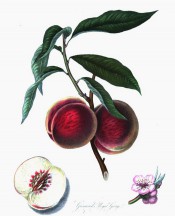Prunus persica ‘Grosse Mignonne’
A Prunus persica (L.) Batsch. cultivar. ‘Fruit large, depressed, hollowed at the summit, with a moderately deep suture, and swelled considerably on one of its sides, and a wide cavity at the base; the side marked by the suture is shorter than the opposite one. Skin rather thinly clad with down, of a rich, very deep red, next the sun, thickly mottled on a yellowish ground next the wall. Flesh pale yellow, rayed with red at the stone, from which it freely separates; melting, juicy, with a rich vinous flavour. Stone small for the size of the fruit, ovate, very rugged. Ripe the beginning and middle of September.’ [George Lindley – Orchard Guide p.259/1831].
Horticultural & Botanical History
‘The excellence of this variety [Grosse Mignonne] will account for the number of different names under which it is cultivated. Some of these have previously been determined as synonyms; a few are now so considered for the first time. It is not improbable that the Marlborough, Ronalds’s Early Gallande, Padleys Early Purple, and the Swiss Mignonne, will be hereafter added to the list; if not the same as the Grosse Mignonne, they differ from it so little as not to be varieties. The Vineuse de Fromentin of the French differs only in being somewhat larger, rather longer, and not so much hollowed at the summit. A beautiful, melting, delicious variety, ripening in the beginning of September. One of the finest Peaches in cultivation.’ [PM t.23/1828].
‘The name of Grimwood's Royal George was given by Mr. Grimwood, to plants which he propagated from the Grosse Mignonne, in the early part of the reign of George the Third; by which he derived a profit beyond what he would have done had he sold them under what he knew to be their proper name. […] It is said the name of Mignonne originated with one of the kings of France, on account of its excellence.’ [George Lindley – Orchard Guide p.259/1831].
Described and figured in Pomona Londinensis, the figure used as illustration here. ‘Mr. Grimwood, the nurseryman of Kensington, told Mr. Aiton, His Majesty’s gardener at Kew, that he gave the name of Grimwood’s Royal George to the old French Peach, in the early part of the Reign of His present Majesty Geoorge III; and in consequence thereof, such was the high sense of loyalty in the nation, sold so many of the kind, as to profit to the amount of 300 pounds by his misnomer. The original stock, by which he gained so much, he gave to Mr. Aiton, and in the year 1813, it existed still in one of the forcing houses at Kew; and in the spring of that year was in full bloom, which could not be distinguished from that of the Grosse Mignonne, which was very near it.’ [PL t.41/1818].
Also figured in Pomona Britannica [PB pl.XXVI/1812].
History at Camden Park
Crop data for this peach is given in a gardening notebook on 18th January 1845, although it never appeared in the catalogues. ‘Largest 5½ oz, 9 inches circumference, average about 5 oz.’ [MP A2948 Notebook 4, p.9/1845]. But see also ‘Royal Kensington’ which is synonymous with this peach.
Notes
Published Jun 03, 2010 - 01:34 PM | Last updated Jul 21, 2011 - 04:58 PM
| Family | Rosaceae |
|---|---|
| Category | |
| Region of origin | Garden origin, France |
| Synonyms |
|
| Common Name | Peach, late summer, autumn |
| Name in the Camden Park Record |
French Mignonne
|
| Confidence level | high |
